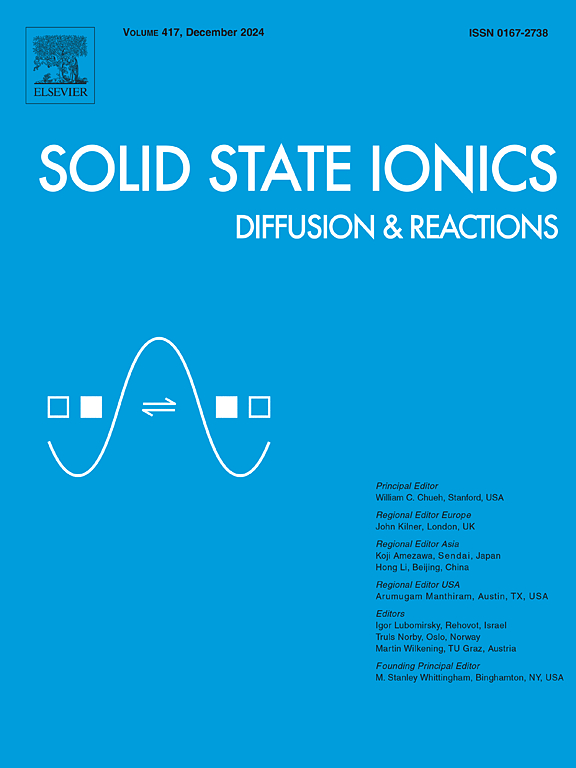锂离子在焦氯型氟化氧Li1.25La0.58Nb2O6F中的快速扩散
IF 3.3
4区 材料科学
Q3 CHEMISTRY, PHYSICAL
引用次数: 0
摘要
具有氧化物框架的快速锂离子导体是高性能固态可充电电池的关键材料。利用脉冲场梯度核磁共振(NMR)和阻抗测量,揭示了Li+离子在新发现的焦绿石型锂镧铌氧氟化锂(Li2-xLa (1+x)/3□(2x-1)/3Nb2O6F(□=空位)中的快速扩散。这些分析证实了Li+离子的快速扩散是高离子电导率的来源。此外,7Li和19F核磁共振数据表明,Li+离子位点的局部无序有利于快速扩散。19F核磁共振的化学位移可以用氟周围的La、Li和空位的数量来解释。阿伦尼乌斯图在大约200k处有轻微的弯曲。在200k时,热膨胀系数也由负变为正。这些结果表明,焦氯型氟氧化物中的Li+离子经历了有序-无序相变。该研究为Li+离子在焦氯型氟氧化物中的快速扩散机制提供了见解,为制造性能优于传统固体电解质的固体电解质铺平了道路。本文章由计算机程序翻译,如有差异,请以英文原文为准。

Fast lithium-ion diffusion in pyrochlore-type oxyfluoride Li1.25La0.58Nb2O6F
Fast lithium-ion conductors with oxide frameworks are key materials for high performance solid-state rechargeable batteries. This study reveals fast Li+ ion diffusion in the recently discovered pyrochlore-type lithium lanthanum niobium oxyfluoride, Li2–xLa(1+x)/3□(2x–1)/3Nb2O6F (□ = vacancy), using pulsed-field gradient nuclear magnetic resonance (NMR) and impedance measurements. These analyses confirm that fast Li+ ion diffusion is the origin of the high ionic conductivity. Moreover, 7Li and 19F NMR data suggest that local disorder at the Li+ ion sites facilitate fast diffusion. Chemical shifts of the 19F NMR can be explained by the number of La, Li and vacancies around fluorine. The Arrhenius plot exhibits a slight bending at approximately 200 K. The thermal expansion coefficient also changes from negative to positive at 200 K. These results suggest that Li+ ions in pyrochlore-type oxyfluorides undergo an order–disorder phase transition. The insights provided by this study into the mechanism of fast Li+ ion diffusion in pyrochlore-type oxyfluorides pave the way for fabricating solid electrolytes with improved performance over conventional solid electrolytes.
求助全文
通过发布文献求助,成功后即可免费获取论文全文。
去求助
来源期刊

Solid State Ionics
物理-物理:凝聚态物理
CiteScore
6.10
自引率
3.10%
发文量
152
审稿时长
58 days
期刊介绍:
This interdisciplinary journal is devoted to the physics, chemistry and materials science of diffusion, mass transport, and reactivity of solids. The major part of each issue is devoted to articles on:
(i) physics and chemistry of defects in solids;
(ii) reactions in and on solids, e.g. intercalation, corrosion, oxidation, sintering;
(iii) ion transport measurements, mechanisms and theory;
(iv) solid state electrochemistry;
(v) ionically-electronically mixed conducting solids.
Related technological applications are also included, provided their characteristics are interpreted in terms of the basic solid state properties.
Review papers and relevant symposium proceedings are welcome.
 求助内容:
求助内容: 应助结果提醒方式:
应助结果提醒方式:


